History of the European Union
| History of the European Union |
|---|
 |
|
|
TheEuropean Unionis ageo-politicalentity, created in 1993, covering a large portion of theEuropean continent.It is founded upon numerous treaties and has undergone expansions and secessions that have taken it from sixmember statesto 27, a majority of the states in Europe.
Since the beginning of the institutionalised modern European integration in 1948, the development of the European Union has been based on asupranationalfoundation that would "make war unthinkable and materially impossible"[1][2]and reinforce democracy amongst its members[3]as laid out byRobert Schumanand other leaders in theSchuman Declaration(1950) and theEurope Declaration(1951). This principle was at the heart of theEuropean Coal and Steel Community(ECSC) (1951), theTreaty of Paris (1951),and later theTreaty of Rome(1958) which established theEuropean Economic Community(EEC) and theEuropean Atomic Energy Community(EAEC). TheMaastricht Treaty(1992) created theEuropean Unionwith itspillars system,including foreign and home affairs alongside theEuropean Communities.This in turn led to the creation of the single European currency,the euro(launched 1999). The ECSC expired in 2002. The Maastricht Treaty has been amended by the treaties ofAmsterdam(1997),Nice(2001) andLisbon(2007), the latter merging the three pillars into a single legal entity, though the EAEC has maintained a distinct legal identity despite sharing members and institutions.
Development of Europe as a region
[edit]Europe as a continent
[edit]The known world inAncient Greecewas differentiated into three landmasses:Asia,"Libya"(Africa) andEurope,giving rise to identifying the European landmass as a coherent area, acontinent.
Roman Europes
[edit]The European landmass was populated and territorialized by many long before its conceptualization as a coherent continent. But theRoman Empire,an empire built on theHellenistic worldandAlexandrian Empire,Ancient Egypt,theLevantandNorth Africa,became the first state to control the wholeMediterranean Basinand also large parts, particularly theSouthernandWestern partsof the European landmass. This historic prominence in the Mediterranean Basin and Europe has been invoked by states that came after it, claiming succession to Roman authority and to legitimate their rule over lands throughout the former Romaneucomene,and therefore also in Europe, particularly in Western Europe, the lands of the laterWestern Roman EmpireoflatinRome.The latter established Western Europe as a coherent and independent political area of Europe, which has taken sometimes prominence, as simplythe West,over the concept of Europe. Similarly other concepts for Europe as a coherent political space have been used, such as for exampleFrangistan.
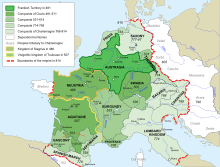
The claims for the succession of the control over the West, afterthe fall of Western Rome in 476developed into the concept oftranslatio imperii( "transfer of rule" ) through theKing of Italy,enabling claims by theGoths,Lombards,Frankish Empire(481/800–843) andHoly Roman Empire(800/962–1806).[a] Furthermore, during and after the Roman Empire the conceptrenovatio imperii( "restoration of the empire" ) was employed,[6]particularly in the forms of the religiously inspiredImperium Christianum( "christian empire" ),[7][8]and later theReichsidee( "imperial idea" ),[9]to establish and sustain a coherent political region. As such the position and extent of influence of thePapacyover a range of European lands has been a force, while not exclusively European, capable of rallying European powers under a common Christian identity.[10][11][12][13] That said, some European powers, such asFrance(after the installment of theHoly Roman EmpirewithEast Francia) and thePolish-Lithuanian Commonwealthchallenged the Western Roman authority through theWestern Schismand theItalian Wars,whileEngland,theDutch Republic,Prussia,theSwedish EmpireandDenmark–Norwayalso challenged the Papal one withProtestant Reformation.
The GreekEastern Rome,also called Byzantine Empire, remained long after the dissolution of the Western Roman Empire, sustaining a coherent political space also over large areas of Europe, particularly of (South-)Eastern Europe,or simplythe East,giving rise to the other major particular Europe. With thefall of the Eastern Roman Empirein 1453, theOttoman Empireand theRussian Tsardom,and ultimately theEmpire(1547–1917), with Moscow as the so-calledThird Rome,used claims of inheritance of the eastern Roman Empire to legitimate their rule over larger areas of Europe, though not exclusively.[14]
- ^The Frankish Empire has had a symbolic relevance for the building of Europe since the 20th century:Charlemagneis often regarded as the "Father of Europe" and a similarity between the borders of Charlemagne's Empire and that of theEuropean Economic Communitywas made explicit during the 1965 Aachen exhibition sponsored by the Council of Europe.[4]Kikuchi Yoshio ( cúc trì lương sinh ) ofMeiji Universitysuggested that the notion ofHoly Roman Empireas a federal political entity influenced the later structural ideas of the European Union.[5]
Other Europes
[edit]But also otherpolitiesof Europe have established, independently from Rome and Byzantine, their European realms, such as a range of pre-Roman or pre-Christian Greek, Germanic, Celtic, Slavic and Hungarian powers,Khanates,orAl-Andalusand theSicilian Emirate.
Ideas of European unity before 1948
[edit]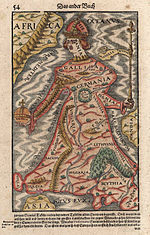
Apart from the ideas offederation,confederation,orcustoms unionsuch asWinston Churchill's 1946 call for a "United States of Europe",the original development of the European Union was based on asupranationalfoundation that would "make war unthinkable and materially impossible"[1][2] A peaceful means of some consolidation of European territories used to be provided bydynastic unions;less common were country-level unions, such as thePolish–Lithuanian CommonwealthandAustro-Hungarian Empire.[15]
In 15th century,King of BohemiaGeorge of Poděbradyproposed theTreaty on the Establishment of Peace throughout Christendomwhich sought to end military conflict between Christian kingdoms of Europe. The treaty proposed a multilateral framework, including a peaceful dispute resolution process, but despite a vigorous promotional campaign, the proposal was ultimately unsuccessful.[16]This effort has been occasionally noted as a first coherent proposal for a proto-European Union.[17]
In theCongress of Aix-la-Chapelle of 1818,Tsar Alexander,as the most advanced internationalist of the day, suggested a kind of permanent European union and even proposed the maintenance of international military forces to provide recognised states with support against changes by violence.[18]
Pan-European political thought truly emerged during the 19th century, inspired by the liberal ideas of theFrenchandAmerican Revolutions.The followingNapoleonic WarsandFirst French Empire(1804–1815), brought down theHoly Roman Empire,enablednationalismand following theCongress of Vienna,[19]the ideals of internationalism like withImmanuel Kantand European unity flourished across the continent, especially in the writings ofWojciech Jastrzębowski(1799–1882)[20]orGiuseppe Mazzini(1805–1872).[21]The termUnited States of Europe(French:États-Unis d'Europe) was used at that time byVictor Hugo(1802–1885) during a speech at theInternational Peace Congressheld in Paris in 1849:
A day will come when all nations on our continent will form a European brotherhood... A day will come when we shall see... the United States of America and the United States of Europe face to face, reaching out for each other across the seas.[22]
From World War I to World War II
[edit]

During theinterwar period,the consciousness that national markets in Europe were interdependent though confrontational, along with the observation of a larger and growing US market on the other side of the ocean, nourished the urge for the economic integration of the continent.[23]In 1920, advocating the creation of a Europeaneconomic union,the British economistJohn Maynard Keyneswrote that "a Free Trade Union should be established... to impose no protectionist tariffs whatever against the produce of other members of the Union."[24]During the same decade, theAustrianRichard von Coudenhove-Kalergi,in light of the dissolution of theHabsburg Empire,imagined as one of the first modern political unions of Europe, founded thePan-Europa Movement.[25]His ideas influenced his contemporaries, among whom was then-Prime Minister of FranceAristide Briand.As French prime minister,Nobel Peace Prize laureatefor theLocarno Treatiesand follower of the Paneuropean Union Aristide Briand delivered a widely recognized speech at theLeague of Nations,the precursor of theUnited Nations,[26]inGenevaon 5 September 1929 for afederal Europeto secure Europe and settle the historicFranco-German enmity.[27][28]
World War II (1939-1945)
[edit]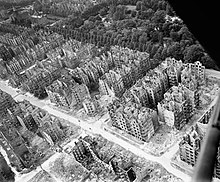
World War IIfrom 1939 to 1945 demonstrated more than ever the horrors of war, but particularly also ofextremism,of discrimination and of genocide. As with devastating wars before, there was a desire to ensure it could never happen again, particularly with the war bringing the worldnuclear weapons.Most European countries failed to maintain theirGreat Powerstatus, with the exception of theSoviet Union,which became a superpower after World War II and maintained that status for 45 years. This left two rival ideologically opposed superpowers.[29]
With large scale war being waged in Europe once again in the 1930s and becomingWorld War II,the question of what to fight against and what for, had to be agreed on. A first agreement was theDeclaration of St James's Palaceof 1941, whenEurope's resistancegathered in London. This was expanded on by the 1941Atlantic Charter,establishing theAlliesand their common goals, inciting a new wave of global international institutions like theUnited Nations(founded 1945) or theBretton Woods System(1944).[30]
During the1943 Moscow ConferenceandTehran Conferenceplans to establish joint institutions for a post-war world and Europe became increasingly an agenda. This led to a decision at theYalta Conferencein 1944 to form aEuropean Advisory Commission,later replaced by theCouncil of Foreign Ministersand theAllied Control Council,following the German surrender and thePotsdam Agreementin 1945.
With war still raging, resistance movements formulated their vision of a post-war Europe, theVentotene prison Manifestoof 1941 byAltiero Spinellipropagated European integration through theItalian Resistanceand after 1943 through the ItalianEuropean Federalist Movement.In March 1943, in a radio address, theUnited Kingdom's leader SirWinston Churchillspoke warmly of "restoring the true greatness of Europe" once victory had been achieved, and mused on the post-war creation of a "Council of Europe" which would bring the European nations together to build peace.[31][32]
Aftermath (1945-1948)
[edit]
By the end of the war European integration became seen as an antidote to theextreme nationalismwhich caused the war.[33]On 19 September 1946 in a much recognized speechWinston Churchillreiterated his calls since 1930 for a "European Union" and "Council of Europe", at theUniversity of Zürich.After leaving office, Churchill called as a civilian for aUnited States of Europe.Coincidentally[34]parallel to his speech theHertenstein Congressin the Lucerne Cantonwas being held, resulting in theUnion of European Federalists,[35]one of the then founded and later constituting members of theEuropean Movement.Richard von Coudenhove-Kalergi,who successfully established during theinterwar periodthe oldest organization for European integration, thePaneuropean Union,founded in June 1947 theEuropean Parliamentary Union(EPU). To ensure Germany could never threaten the peace again, its heavy industry was partly dismantled (See:Allied plans for German industry after World War II) and its main coal-producing regions were either awarded to neighbouring countries (Silesia), managed as separate directly by an occupying power (Saarland)[36]or put under international control (Ruhr area).[37][38]
Though by 1947 a growing rift between the western Allied Powers and theSoviet Unionbecame evident as a result of the rigged1947 Polish legislative electionwhich constituted an open breach of theYalta Agreement,followed by the announcement of theTruman Doctrineon 12 March 1947. On 4 March 1947 France and the United Kingdom signed theTreaty of Dunkirkfor mutual assistance in the event of future military aggression in the aftermath ofWorld War IIagainst any of the pair. The rationale for the treaty was the threat of a potential future military attack, specifically a Soviet one in practice, though publicised under the disguise of a German one, according to the official statements. Immediately following theFebruary 1948 coup d'étatby theCommunist Party of Czechoslovakia,theLondon Six-Power Conferencewas held, resulting in theSovietboycott of the Allied Control Council and its incapacitation, an event marking the beginning of theCold War.The remainder of the year 1948 marked the beginning of the institutionalised modern European integration.
Initial years (1948–57)
[edit]
With the start of theCold War,theTreaty of Brusselswas signed in 1948 establishing theWestern Union(WU) as the first organisation, followed by theInternational Authority for the Ruhr.In the same year, theOrganization for European Economic Co-operation,the predecessor of the OECD, was also founded to manage theMarshall Plan;theEastern Blocresponded with establishing theComecon.
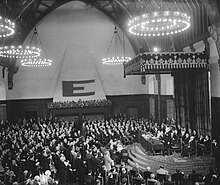
A pivotal moment in European integration was theHague Congressof May 1948, as it led to the creation of theEuropean Movement International,theCollege of Europe[39]and most importantly to the founding of theCouncil of Europeon the 5th of May 1949 (now known asEurope Day). The Council of Europe was the first institution to bring the sovereign nations of Western Europe together, raising great hopes and fevered debates in the following two years for further European integration.[citation needed]It has since been a broad forum to further cooperation and shared issues, achieving things like the 1950-signedEuropean Convention on Human Rights.
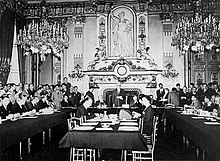
Essential for the actual birth of the institutions of the EU was the 9th of May 1950Schuman Declaration(on the day after the fifthVictory Day,today'sEurope day– of the EU). On the basis of that speech, France, Italy, theBeneluxcountries (Belgium, Netherlands andLuxembourg) together withWest Germanysigned theTreaty of Paris (1951)creating theEuropean Coal and Steel Communitythe following year; this took over the role of theInternational Authority for the Ruhr[37]and lifted some restrictions on German industrial productivity. It gave birth to the first institutions, such as the High Authority (now theEuropean Commission) and the Common Assembly (now theEuropean Parliament). The first presidents of those institutions wereJean MonnetandPaul-Henri Spaakrespectively. Thefounding fathers of the European Unionunderstood that coal and steel were the two industries essential for waging war, and believed that by tying their national industries together, a future war between their nations became much less likely.[40]Backed by theMarshall Planwith large funds coming from the United States since 1948, the ECSC became a milestone organization, enabling European economic development and integration and being the origin of the main institutions of the EU such as theEuropean CommissionandParliament.[41]
The formation of the European Coal and Steel Community was advanced byAmericanSecretary of StateGeorge C. Marshall.Hisnamesake plan to rebuild Europein the wake of World War II contributed more than $100 billion in today's[when?]dollars to the Europeans, helping to feed Europeans, deliver steel to rebuild industries, provide coal to warm homes, and construct dams to help provide power. In doing so, the Marshall Plan encouraged the integration of European powers into the European Coal and Steel Community, the precursor to present-day European Union, by illustrating the effects of economic integration and the need for coordination. The potency of the Marshall Plan caused former German ChancellorHelmut Schmidtto remark in 1997 that "America should not forget that the development of the European Union is one of its greatest achievements. Without the Marshall Plan it perhaps would never have come to that."[42][43]
Paralleling Schuman, thePleven Planof 1951 tried, but failed to tie the institutions of the developing European community under theEuropean Political Community,which was to include the also proposedEuropean Defence Community,an alternative toWest GermanyjoiningNATOwhich was established 1949 under theTruman Doctrine. In 1954 theWestern European Unionwas founded, after NATO took over competences from the WU, and West Germany joined. This prompted theSoviet Unionto form theWarsaw Pactin 1955, allowing it to enforce its standing inEastern Europe.
The attempt to turn theSaar protectorateinto a "European territory" was rejected by a referendum in 1955. The Saar was to have been governed by a statute supervised by a European Commissioner reporting to the Council of Ministers of theWestern European Union.
After the failed attempts at creating defence (European Defence Community) and political communities (European Political Community), leaders met at theMessina Conferenceand established theSpaak Committeewhich produced theSpaak report.The report was accepted at theVenice Conference(29 and 30 May 1956), which decided to organise anIntergovernmental Conference.TheIntergovernmental Conference on the Common Market and Euratomfocused on economic unity, leading to theTreaties of Romebeing signed in 1957 - this established theEuropean Economic Community(EEC) and theEuropean Atomic Energy Community(Euratom) among the members.[44]
1958–1972: Three communities
[edit]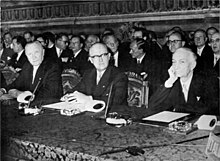
The two new communities were created separately from ECSC, although they shared the same courts and the Common Assembly. The executives of the new communities were called Commissions, as opposed to the "High Authority". The EEC was headed byWalter Hallstein(Hallstein Commission) and Euratom was headed byLouis Armand(Armand Commission) and thenÉtienne Hirsch.Euratom would integrate sectors innuclear energywhile the EEC would develop acustoms unionbetween members.[44][45][46]
Throughout the 1960s tensions began to show with France seeking to limit supranational power and rejecting the membership of the United Kingdom. However, in 1965 an agreement was reached to merge the three communities under a single set of institutions, and hence theMerger Treatywas signed in Brussels and came into force on 1 July 1967 creating theEuropean Communities.[47]Jean Reypresided overthe first merged Commission (Rey Commission).
While the political progress of the Communities was hesitant in the 1960s, this was a fertile period for European legal integration.[48]Many of the foundational legal doctrines of the Court of Justice were first established in landmark decisions during the 1960s and 1970s, above all in theVan Gend en Loosdecision of 1963 that declared the "direct effect" ofEuropean law,that is to say, its enforceability before national courts by private parties.[49]Other landmark decisions during this period includedCosta v ENEL,which established the supremacy of European law over national law[50]and the"Dairy Products" decision,which declared that general international law principles of reciprocity and retaliation were prohibited within the European Community.[51]All three of these judgments were made after the appointment of French judgeRobert Lecourtin 1962, and Lecourt appears to have become a dominant influence on the Court of Justice over the 1960s and 1970s.[52]
1973–1993: Enlargement to Delors
[edit]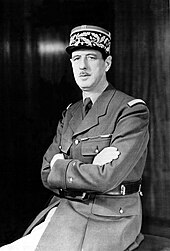
After much negotiation, and following a change in theFrench Presidency,Denmark, Ireland and the United Kingdom (withGibraltar) eventually joined the European Communities on 1 January 1973. This was the first of several enlargements which became a major policy area of the Union (see:Enlargement of the European Union).[53]
In 1979, theEuropean Parliamentheld its first direct elections byuniversal suffrage.410 members were elected, who then elected the first femalePresident of the European Parliament,Simone Veil.[54]
A further enlargement took place in 1981 with Greece joining on 1 January, six years after applying. In 1982,Greenlandvoted to leave the Communityafter gaininghome rulefrom Denmark (See also:Special member state territories and the European Union).Spainand Portugal joined (having applied in 1977) on 1 January 1986 in the third enlargement.[55]

Recently appointed Commission PresidentJacques Delors(Delors Commission) presided over the adoption of theEuropean flagby the Communities in 1986. In the first major revision ofthe treatiessince the Merger Treaty, leaders signed theSingle European Actin February 1986. The text dealt with institutional reform, including extension of community powers – in particular in regarding foreign policy. It was a major component in completing the single market and came into force on 1 July 1987.[56] In 1987Turkeyformally applied to join the Community and began the longest application process for any country. After the1988 Polish strikesand thePolish Round Table Agreement,the first small signs of opening in Central Europe appeared. The opening of a border gate between Austria and Hungary at thePan-European Picnicon August 19, 1989 then set in motion a peaceful chain reaction, at the end of which there was no longer a GDR and theEastern Blochad disintegrated.Otto von HabsburgandImre Pozsgaysaw the event as an opportunity to testMikhail Gorbachev`s reaction to an opening of theIron Curtain.[57]In particular, it was examined whether Moscow would give the Soviet troops stationed in Hungary the command to intervene.[58]But with the mass exodus at the Pan-European Picnic, the subsequent hesitant behavior of theSocialist Unity Party of East Germanyand the non-intervention of the Soviet Union broke the dams. So the bracket of the Eastern Bloc was broken and as a result theBerlin Wallfell together with the whole Iron Curtain.[59][60]Germanyreunifiedand the door to enlargement to the formerEastern Blocwas opened (See also:Copenhagen Criteria).[61][62]
With a wave of new enlargements on the way, theMaastricht Treatywas signed on 7 February 1992 which established the European Union when it came into force the following year.
1993–2004: Creation
[edit]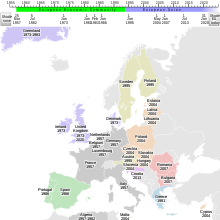
On 1 November 1993, under the thirdDelors Commission,theMaastricht Treatybecame effective, creating theEuropean Unionwith itspillar system,including foreign and home affairs alongside theEuropean Community.[63][64]The1994 European electionswere held resulting in theParty of European Socialistsmaintaining their position as the largest party in Parliament. The Council proposedJacques SanterasCommission Presidentbut he was seen as a second choice candidate, undermining his position. Parliament narrowly approved Santer buthis commissiongained greater support, being approved by 416 votes to 103. Santer had to use his new powers under Maastricht to flex greater control over his choice of Commissioners. They took office on 23 January 1995.[65]
On 30 March 1994, accession negotiations concluded withAustria,SwedenandFinland.Meanwhile,Norway,IcelandandLiechtensteinjoined theEuropean Economic Area(which entered into force on 1 January 1994), an organisation that allowedEuropean Free Trade Associationstates to enter theSingle European Market.The following year, theSchengen Agreementcame into force between seven members, expanding to include nearly all others by the end of 1996. The 1990s also saw the further development of theeuro.1 January 1994 saw the second stage of theEconomic and Monetary Union of the European Unionbegin with the establishment of theEuropean Monetary Instituteand at the start of 1999 the euro as a currency was launched and theEuropean Central Bankwas established. On 1 January 2002, notes and coins were put into circulation, replacing the old currencies entirely.
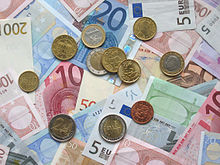
During the 1990s, theconflicts in the Balkansgave impetus to developing the EU'sCommon Foreign and Security Policy(CFSP). The EU failed to react during the beginning of the conflict, andUN peacekeepersfrom the Netherlands failed to prevent theSrebrenica massacre(July 1995) inBosnia and Herzegovina,the largest mass murder in Europe since the Second World War. TheNorth Atlantic Treaty Organization(NATO) finally had tointervene in the war,forcing the combatants to the negotiation table. The early foreign policy experience of the EU led to foreign policy being emphasised in theTreaty of Amsterdam(which created theHigh Representative).[66]
However, any success was overshadowed by the budget crisis in March 1999. The Parliament refused to approve the Commission's 1996community's budgeton grounds of financial mismanagement, fraud and nepotism. With Parliament ready to throw them out, the entireSanter Commissionresigned.[67][68]The post-Delors mood of euroscepticism became entrenched with the Council and Parliament constantly challenging the Commission's position in coming years.[69]
In thefollowing elections,the Socialists lost their decades-old majority to the newPeople's Partyand the incomingProdi Commissionwas quick to establish the newEuropean Anti-Fraud Office(OLAF).[70]Under the new powers of the Amsterdam Treaty, Prodi was described by some as the 'First Prime Minister of Europe'.[71]On 4 June,Javier Solanawas appointed Secretary General of the Council and the strengthenedHigh Representative for the Common Foreign and Security Policyadmitted the intervention in Kosovo – Solana was also seen by some as Europe's firstForeign Minister.[72]TheNice Treatywas signed on 26 February 2001 and entered into force on 1 February 2003 which made the final preparations before the2004 enlargement to 10 new members.
2004–2007: The great enlargement and consolidation
[edit]
On 10–13 June 2004, the 25 member states participated in the largest trans-national election in history (with the second largest democratic electorate in the world). The result of thesixth Parliamentary electionwas a second victory for theEuropean People's Party-European Democratsgroup. It also saw the lowestvoter turnoutof 45.5%, the second time it had fallen below 50%.[73]On 22 July 2004,José Manuel Barrosowas approved by the new Parliament as the next Commission President. However, his new team of 25 Commissioners faced a tougher road. With Parliament raising objections to a number of his candidates he was forced to withdraw his selection and try once more. The Prodi Commission had to extend their mandate to 22 November after the new line-up of commissioners was finally approved.[74]
A proposedconstitutional treatywas signed byplenipotentiariesfrom EU member states on 28 October 2004. The document was ratified in most member states, including two positive referendums. Thereferendums that were held in Franceandthe Netherlandsfailed however, killing off the treaty. The European Council agreed that the constitution proposal would be abandoned, but most of its changes would be retained in an amending treaty. On 13 December 2007 the treaty was signed, containingopt-outsfor the moreeuroscepticmembers and no state-like elements. The Lisbon treaty finally came into force on 1 December 2009. It created the post ofPresident of the European Counciland significantly expanded the post ofHigh Representative.After much debate about what kind of person should be President, the European Council agreed on a low-key personality and choseHerman Van Rompuywhile foreign policy-noviceCatherine Ashtonbecame High Representative.
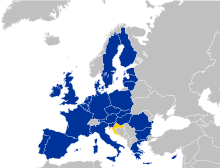
The2009 electionsagain saw a victory for theEuropean People's Party,despite losing theBritish Conservativeswho formed a smaller euroscepticEuropean Conservatives and Reformistsgrouping with other anti-federalist right wing parties. Parliament's presidency was once again divided between the People's Party and the Socialists, withJerzy Buzekelected as the firstPresident of the European Parliamentfrom an ex-communist country. Barroso was nominated by the Council for a second term and received backing from EPP who had declared him as their candidate before the elections. However, the Socialists and Greens led the opposition against him despite not agreeing on an opposing candidate. Parliament finally approved Barroso II, though once more several months behind schedule.
In 2007, thefifth enlargement completedwith the accession ofBulgariaandRomaniaon 1 January 2007. Also, in 2007 Slovenia adopted the euro,[75]Malta and Cyprus in 2008[76]and Slovakia in 2009.
2008–2016: European crisis
[edit]However, trouble developed with existing members as theeurozoneentered its first recession in 2008.[77]Members cooperated and the ECB intervened to help restore economic growth and the euro was seen as a safe haven, particularly by those outside such as Iceland.[78][79][80]With the risk of a default inGreece, Ireland, Portugal and other members in late 2009–10,eurozone leaders agreed to provisions for loans to member states who could not raise funds. Accusations that this was a U-turn on the EU treaties, which rule out any bail out of a euro member in order to encourage them to manage their finances better, were countered by the argument that these were loans, not grants, and that neither the EU nor other Member States assumed any liabilities for the debts of the aided countries. WithGreece struggling to restore its finances,other member states also at risk and the repercussions this would have on the rest of the eurozone economy, a loan mechanism was agreed. The crisis also spurred consensus for further economic integration and a range of proposals such as aEuropean Monetary Fundor federal treasury.[81][82][83]
The European Union received the2012 Nobel Peace Prizefor having "contributed to the advancement of peace and reconciliation, democracy andhuman rights in Europe."[84][85]TheNobel Committeestated that "that dreadful suffering inWorld War IIdemonstrated the need for a new Europe [...] today war between Germany and France is unthinkable. This shows how, through well-aimed efforts and by building up mutual confidence, historical enemies can become close partners. "[86]The Nobel Committee's decision was subject to considerable criticism.[87]
On 1 July 2013, Croatiajoined the EU,and on 1 January 2014 the FrenchIndian Oceanterritory ofMayottewas added as an outermost region.[88]
2016–2020: Brexit
[edit]
On 23 June 2016, the citizens of the United Kingdom voted towithdraw from the European Unionin a referendum and subsequently became the first and to date only member to triggerArticle 50 of the Treaty on European Union (TEU).The vote was in favour of leaving the EU by a margin of 51.9% in favour to 48.1% against.[89]The UK's withdrawal was completed on 31 January 2020.
2020–2022: Impact of the COVID-19 pandemic
[edit]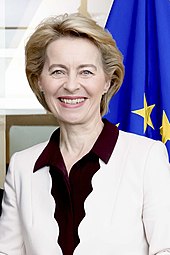
(since 1 December 2019)
After theeconomic crisiscaused by theCOVID-19 pandemicthe EU leaders agreed for the first time to emit common debt to finance the European Recovery Program calledNext Generation EU(NGEU).[90]
2022–present: Impact of the Russo-Ukrainian War
[edit]On 24 February 2022, after massing near the borders of Ukraine, theRussian Armed Forcesundertook afull-scale invasion of Ukraine.[91][92]
The European Union imposedheavy sanctions on Russiaand agreed on a pooled military aid package to Ukraine for lethal weapons funded via theEuropean Peace Facilityoff-budget instrument.[93][94]Likewise, neighbouring EU member countries received amass influx of Ukrainian refugeesfleeing the conflict over the course of the first weeks of the war.[95]The conflict exposed the EU energy dependency on Russia, deemed as a supplier "explicitly" threatening the EU.[96]This development injected a sense of urgency in the switch towards alternative energy suppliers and further development of clean energy sources.[96]
Reform
[edit]Multi-speed Europeis a concept ofdifferentiated integrationcurrently in operation that has recently been given renewed emphasis by a team of independent experts[97]in a report presented at acouncil meetingin Brussels in September of 2023.[98][99]"France and Germany are pushing for a larger EU reform before any new member joins the bloc."[100]
Structural evolution
[edit]Since the end ofWorld War II,sovereignEuropeancountries have entered into treaties and thereby co-operated and harmonised policies (orpooled sovereignty) in an increasing number of areas, in theEuropean integration projector theconstruction of Europe(French:la construction européenne). The following timeline outlines the legal inception of theEuropean Union(EU)—the principal framework for this unification. The EU inherited many of its present responsibilities from theEuropean Communities(EC), which were founded in the 1950s in the spirit of theSchuman Declaration.
| Legend: S: signing F: entry into force T: termination E: expiry de factosupersession Rel. w/ EC/EU framework: de factoinside outside |
[Cont.] | |||||||||||||||||
| (Pillar I) | ||||||||||||||||||
| European Atomic Energy Community(EAEC or Euratom) | [Cont.] | |||||||||||||||||
| European Economic Community(EEC) | ||||||||||||||||||
| Schengen Rules | European Community (EC) | |||||||||||||||||
| 'TREVI' | Justice and Home Affairs(JHA,pillar II) | |||||||||||||||||
| [Cont.] | Police and Judicial Co-operation in Criminal Matters(PJCC,pillar II) | |||||||||||||||||
Anglo-French alliance |
[Defence armhandedtoNATO] | European Political Co-operation(EPC) | Common Foreign and Security Policy (CFSP,pillar III) | |||||||||||||||
| [Tasksdefined following the WEU's 1984reactivationhandedto theEU] | ||||||||||||||||||
| [Social, cultural taskshandedtoCoE] | [Cont.] | |||||||||||||||||
Entente Cordiale
S: 8 April 1904 |
Davignon report
S: 27 October 1970 |
European Council conclusions
S: 2 December 1975 |
||||||||||||||||
- ^abcdeAlthough not EU treatiesper se,these treaties affected thedevelopmentof the EU defence arm, a main part of the CFSP. The Franco-British alliance established by the Dunkirk Treaty wasde factosuperseded by WU. The CFSP pillar was bolstered by some of the security structures that had been established within the remit of the 1955Modified Brussels Treaty(MBT). The Brussels Treaty wasterminatedin 2011, consequently dissolving the WEU, as themutual defence clausethat the Lisbon Treaty provided for EU was considered to render the WEU superfluous. The EU thusde factosuperseded the WEU.
- ^Plans to establish aEuropean Political Community(EPC) were shelved following the French failure to ratify theTreaty establishing the European Defence Community(EDC). The EPC would have combined the ECSC and the EDC.
- ^TheEuropean Communitiesobtained common institutions and a sharedlegal personality(i.e. ability to e.g. sign treaties in their own right).
- ^The treaties of Maastricht and Rome form the EU'slegal basis,and are also referred to as theTreaty on European Union(TEU) and theTreaty on the Functioning of the European Union(TFEU), respectively. They are amended by secondary treaties.
- ^Between the EU's founding in 1993 and consolidation in 2009, the union consisted ofthree pillars,the first of which were the European Communities. The other two pillars consisted of additional areas of cooperation that had been added to the EU's remit.
- ^The consolidation meant that the EU inherited the European Communities'legal personalityand that thepillar system was abolished,resulting in the EU framework as such covering all policy areas. Executive/legislative power in each area was instead determined by adistribution of competenciesbetweenEU institutionsandmember states.This distribution, as well as treaty provisions for policy areas in which unanimity is required andqualified majority votingis possible, reflects the depth of EU integration as well as the EU's partlysupranationaland partlyintergovernmentalnature.
See also
[edit]- Timeline of European Union history
- Enlargement of the European Union
- History of the euro
- History of the Common Security and Defence Policy
- List of European Councils
- List of presidents of the institutions of the European Union
- Founding fathers of the European Union
- History of the European Union in Brussels
- History of the location of EU institutions
- History of Europe
- House of European History
- Virtual Centre for Knowledge on EuropeMultimedia source collections on EU History
- Wider European history between World War II and the fall of Communism in Europe 1945–1992
- End of World War II in Europe
- Cold War
- Revolutions of 1989
- German reunification
- Yugoslavia and the European Economic Community
- Breakup of Yugoslavia
- Wider European history after the creation of the European Union
- Maastricht Treaty
- History of the European Union (1993–2004)
- History of the European Union (since 2004)
- Eurozone
- 2006 Montenegrin independence referendum
- 2008 Kosovo declaration of independencefrom Serbia
- European sovereign-debt crisis
References
[edit]- ^ab"Schuman Project".schuman.info.
- ^ab"Schuman Project".schuman.info.
- ^"Schuman Project".schuman.info.
- ^Story, Joanna (2005).Charlemagne: Empire and Society.Manchester University Press. pp. 2–3.ISBN978-0-7190-7089-1.
- ^Kikuchi ( cúc trì ), Yoshio ( lương sinh ) (2003).Thần thánh ローマ đế quốc.Giảng nói xã. p. 264.ISBN978-4-06-149673-6.
- ^Corbet, Patrick (2002)."Renovatio imperii romanorum".InVauchez, André(ed.).Oxford Encyclopedia of the Middle Ages.James Clarke & Co.ISBN978-0-227-67931-9.
- ^Folz, Robert (1969).The concept of empire in Western Europe from the fifth to the fourteenth century.London: Edward Arnold. p. 65.ISBN978-0-7131-5451-1.OCLC59622.
- ^Gorp, Bouke Van; Renes, Hans (2007)."A European Cultural Identity? Heritage and shared histories in the European Union"(PDF).Tijdschrift voor Economische en Sociale Geografie.98(3): 411.doi:10.1111/j.1467-9663.2007.00406.x.ISSN1467-9663.S2CID55529057.Archived(PDF)from the original on 9 October 2022.
For the last two thousand years, the Christian church has attempted to unify Europe in cultural terms. Christianity did not originate in Europe but, building upon the organisation of the Roman Empire, has tried throughout the Middle Ages to become a Europe-wide organisation.
- ^Schramm, Percy E. (1957).Kaiser, Rom und Renovatio; Studien zur Geschichte des römischen Erneuerungsgedankens vom Ende des karolingischen Reiches bis zum Investiturstreit(in German). Darmstadt: Wissenschaftliche Buchgesellschaft. p. 143.OCLC15021725.
- ^Pagden & Hamilton 2002,p. 89.
- ^Mather 2006,pp. 16–18.
- ^Nelsen, Brent F.; Guth, James L. (2015).Religion and the Struggle for European Union: Confessional Culture and the Limits of Integration.Georgetown University Press. pp.48–49.ISBN978-1-62616-070-5.
- ^Perkins, Mary Anne (2004).Christendom and European Identity: The Legacy of a Grand Narrative Since 1789.Walter de Gruyter. p.341.ISBN978-3-11-018244-6.
- ^Skolimowska, Anna (2018).Perceptions of the European Union's Identity in International Relations.Routledge.ISBN978-1-351-00560-9.
- ^"The World Factbook".cia.gov.16 February 2022.
- ^Le Goff, Jacques; Le Goff, Jacques (2005).The birth of Europe.The making of Europe (1. publ ed.). Malden, Mass.: Blackwell. pp. 158–159.ISBN978-0-631-22888-2.
- ^Koten, Marek (21 September 2022)."George of Bohemia: The Father of the European Union".3 Seas Europe.Retrieved17 July2024.
- ^R. R. Palmer.A History of the Modern World.p. 461.
- ^Ghervas, Stella (2014). "Antidotes to Empire: From the Congress System to the European Union". In Boyer, John W.; Molden, Berthold (eds.).EUtROPEs. The Paradox of European Empire.University of Chicago Center in Paris. pp. 49–81.ISBN978-2-9525962-6-8.
- ^Pinterič, Uroš; Prijon, Lea (2013).European Union in 21st Century.University of SS. Cyril and Methodius, Faculty of Social Sciences.ISBN978-80-8105-510-2.
- ^Mack Smith, Denis(2008).Mazzini.Yale University Press.ISBN978-0-300-17712-1.
- ^Metzidakis, Angelo (1994). "Victor Hugo and the Idea of the United States of Europe".Nineteenth-Century French Studies.23(1/2): 72–84.JSTOR23537320.
- ^Kaiser & Varsori 2010,p. 140.
- ^John Maynard Keynes,Economic Consequences of the Peace,New York: Harcourt, Brace & Howe, 1920, pp. 265–66.
- ^Rosamond, Ben (2000),Theories of European Integration,Palgrave Macmillan, pp. 21–22,OCLC442641648
- ^Weigall, David; Stirk, Peter M. R., eds. (1992),The Origins and Development of the European Community,Leicester: Leicester University Press, pp. 11–15,ISBN9780718514280
- ^Schulz, Matthias (3 December 2010)."Der Briand-Plan und der Völkerbund als Verhandlungsarena für die europäische Einigung zwischen den Kriegen"(in German). IEG(http:// ieg-mainz.de).Retrieved16 November2023.
- ^Nelsson, Richard (5 September 2019)."Aristide Briand's plan for a United States of Europe".the Guardian.Retrieved16 November2023.
- ^Europe in ruins in the aftermath of the Second World Warena.lu
- ^"Milestones: 1937–1945".Office of the Historian.8 March 1946.Retrieved16 November2023.
- ^Klos, Felix (2017).Churchill's Last Stand: The Struggle to Unite Europe.Bloomsbury Publishing. p. 51.ISBN978-1-78673-292-7.
- ^Churchill, Winston (21 March 1943)."National Address".The International Churchill Society.
- ^"The political consequences".CVCE.Retrieved28 April2013.
- ^"Union of European Federalists (UEF): Churchill and Hertenstein".Union of European Federalists (UEF).Retrieved17 May2022.
- ^"Ein britischer Patriot für Europa: Winston Churchills Europa-Rede, Universität Zürich, 19. September 1946"[A British Patriot for Europe: Winston Churchill's Speech on Europe University of Zurich, 19 September 1946].Zeit Online.Retrieved13 January2010.
- ^Encyclopaedia Britannica (12 September 2019)."Saarland".Retrieved19 August2021.
- ^abYoder, Amos (July 1955)."The Ruhr Authority and the German Problem".Review of Politics.17(3). Cambridge University Press: 345–358.doi:10.1017/S0034670500014261.S2CID145465919.
- ^*French proposal regarding the detachment of German industrial regions8 September 1945
France, Germany and the Struggle for the War-making Natural Resources of the RhinelandLetter from Konrad Adenauer to Robert Schuman(26 July 1949) Warning him of the consequences of the dismantling policy. (requires Flash Player)
Letter from Ernest Bevin to Robert Schuman(30 October 1949) British and French foreign ministers. Bevin argues that they need to reconsider the Allies' dismantling policy in the occupied zones (requires Flash Player) - ^Dieter Mahncke;Léonce Bekemans;Robert Picht,eds. (1999).The College of Europe. Fifty Years of Service to Europe.Bruges:College of Europe.ISBN978-90-804983-1-0.Archived fromthe originalon 28 December 2016.
- ^"A peaceful Europe – the beginnings of cooperation".European Commission.Retrieved12 December2011.
- ^Blocker, Joel (9 April 2008)."Europe: How The Marshall Plan Took Western Europe From Ruins To Union".Radio Free Europe/Radio Liberty.Retrieved20 June2019.
- ^Schmidt, Helmut(6 June 1997)."Helmut Schmidt über den Marshallplan und die europäische Einheit: Mit voller Kraft ins nächste Jahrhundert"(in German).Die Zeit.
Und Amerika sollte nicht vergessen, daß die Entstehung der Europäischen Union eine seiner größten Leistungen ist. Ohne den Marshallplan wäre es vielleicht nie dazu gekommen.
- ^Blocker, Joel (9 May 1997)."Europe: How The Marshall Plan Took Western Europe From Ruins To Union".Radio Free Europe/Radio Liberty.Retrieved20 June2019.
Witness the recent words of former German Chancellor Helmut Schmidt: 'The United States ought not to forget that the emerging European Union is one of its greatest achievements: it would never have happened without the Marshall Plan.' [The "vielleicht" in the original quote is missing in this translation.]
- ^abA peaceful Europe – the beginnings of cooperationeuropa.eu
- ^A European Atomic Energy Communityena.lu
- ^A European Customs Unionena.lu
- ^Merging the executivesena.lu
- ^Lecourt, Robert (1976). L'Europe des juges. Bruxelles, Bruylant. Stein, Eric (1981). 'Lawyers, Judges, and the Making of a Transnational Constitution.' American Journal of International Law 75(1): 1–27. Weiler, Joseph H. H. (1991). 'The Transformation of Europe.' Yale Law Journal 100: 2403–2483.
- ^ECJ Case 26/62
- ^ECJ Case 6/64
- ^ECJ Cases 90&91/63, Commission v Luxembourg & Belgium. See e.g. Phelan, William (2016). 'Supremacy, Direct Effect, and Dairy Products in the Early History of European law.' International Journal of Constitutional Law 14: 6–25.
- ^W. Phelan, Great Judgments of the European Court of Justice: Rethinking the Landmark Decisions of the Foundational Period (Cambridge, 2019)
- ^The first enlargementcvce.eu
- ^The new European Parliamentcvce.eu
- ^Negotiations for enlargementcvce.eu
- ^Single European Actcvce.eu
- ^Miklós Németh in Interview, Austrian TV - ORF "Report", 25 June 2019
- ^„Der 19. August 1989 war ein Test für Gorbatschows “(German - August 19, 1989 was a test for Gorbachev), in: FAZ 19 August 2009.
- ^Michael Frank: Paneuropäisches Picknick – Mit dem Picknickkorb in die Freiheit (German: Pan-European picnic - With the picnic basket to freedom), in: Süddeutsche Zeitung 17 May 2010.
- ^Ludwig Greven "Und dann ging das Tor auf", in Die Zeit, 19 August 2014.
- ^The fall of the Berlin Wallena.lu
- ^Andreas Rödder, Deutschland einig Vaterland – Die Geschichte der Wiedervereinigung (2009).
- ^1993europa.eu
- ^Characteristics of the Treaty on European Unioncvce.eu
- ^"The crisis of the Santer Commission".Centre Virtuel de la Connaissance sur l'Europe (CVCE).Retrieved29 January2013.
- ^The Treaty of Amsterdamena.lu
- ^Ringer, Nils F. (February 2003)."The Santer Commission Resignation Crisis"(PDF).University of Pittsburgh.Archived(PDF)from the original on 30 August 2006.Retrieved7 October2007.
- ^Hoskyns, Catherine; Michael Newman (2000).Democratizing the European Union: Issues for the twenty-first Century (Perspectives on Democratization).Manchester University Press.pp. 106–7.ISBN978-0-7190-5666-6.
- ^Topan, Angelina (30 September 2002)."The resignation of the Santer-Commission: the impact of 'trust' and 'reputation'".European Integration online Papers.Retrieved7 October2007.
- ^"EU Budget Fraud".politics.co.uk. Archived fromthe originalon 19 June 2006.Retrieved7 October2007.
- ^Prodi to Have Wide, New Powers as Head of the European Commissioniht 16 April 1999
- ^Javier Solana/Spain: Europe's First Foreign Minister?businessweek
- ^Vote EU 2004news.bbc.co.uk
- ^The new commission – some initial thoughtsArchived23 September 2006 at theWayback Machinebmbrussels.b
- ^"Slovenia clear to adopt the euro".British Broadcasting Corporation.16 June 2006.Retrieved18 January2009.
- ^"Cyprus and Malta set to join Eurozone in 2008".euractiv.16 May 2007. Archived fromthe originalon 18 October 2007.Retrieved19 January2009.
- ^EU data confirms eurozone's first recessionArchived30 December 2010 at theWayback Machine,EUbusiness, 8 January 2009
- ^"European leaders agree crisis rescue at summit".Eubusiness. Archived fromthe originalon 13 October 2008.Retrieved2 January2009.
- ^Oakley, David and Ralph Atkins (17 September 2009)Eurozone shows its strength in a crisis,Financial Times
- ^Iceland to be fast-tracked into the EU,the Guardian
- ^Willis, Andrew (25 March 2010)Eurozone leaders agree on Franco-German bail-out mechanism,EU Observer
- ^Eurozone overhaulDie Zeit onPresseurop,12 February 2010
- ^Plans emerge for 'European Monetary Fund'EU Observer
- ^The Nobel Peace Prize 2012,Nobelprize.org, 12 October 2012,retrieved12 October2012
- ^"Nobel Committee Awards Peace Prize to E.U.",New York Times,12 October 2012,retrieved12 October2012
- ^The Nobel Peace Prize for 2012,Nobelprize.org, 12 October 2012,retrieved12 October2012
- ^Gaspers, Jan (December 2012)."The European Union and the Nobel Peace Prize: A Criteria-Based Assessment"(PDF).Archived fromthe original(PDF)on 3 February 2013.Retrieved19 December2012.
- ^"EUROPEAN COUNCIL DECISION of 11 July 2012 amending the status of Mayotte with regard to the European Union".europa.eu.
- ^"Labour leadership & Hammond in China – BBC News".Retrieved23 July2016.
- ^"Recovery plan for Europe".ec.europa.eu.Retrieved2 May2021.
- ^"Russia-Ukraine war: humanitarian corridor opened from Sumy; Moscow threatens to cut gas supplies to Europe".theguardian. theguardian. 8 March 2022.Retrieved8 March2022.
- ^"In pictures: Russia invades Ukraine".cnn. cnn. 8 March 2022.Retrieved8 March2022.
- ^Deutsch, Jillian; Pronina, Lyubov (27 February 2022)."EU Approves 450 Million Euros of Arms Supplies for Ukraine".Bloomberg.
- ^"Chelsea's oligarch owner is selling. Will scrutiny of other Premier League owners follow?".washingtonpost.washingtonpost. 8 March 2022.Retrieved8 March2022.
- ^Micinski, Nicholas R. (16 March 2022)."The E.U. granted Ukrainian refugees temporary protection. Why the different response from past migrant crises?".Washington Post.
- ^ab"EU unveils plan to reduce Russia energy dependency".dw.8 March 2022.
- ^Amt, Auswärtiges."German-French working group of experts on EU institutional reforms".German Federal Foreign Office.Retrieved19 September2023.
- ^red, ORF at/Agenturen (19 September 2023)."Expertengruppe empfiehlt umfangreiche EU-Reformen".news.ORF.at(in German).Retrieved19 September2023.
- ^Brzozowski, Alexandra; Pugnet, Aurélie (19 September 2023)."Germany, France make EU reform pitch ahead of enlargement talks".euractiv.Retrieved19 September2023.
- ^Noyan, Oliver (23 June 2023)."EU reform: France, Germany confident on reaching agreement this year".euractiv.Retrieved19 September2023.
Further reading
[edit]- Anderson, P.The New Old World(Verso 2009)ISBN978-1-84467-312-4
- Berend, Ivan T.The History of European Integration: A New Perspective.(Routledge, 2016).
- Blair, Alasdair.The European Union since 1945(Routledge, 2014).
- Chaban, N. and M. Holland, eds.Communicating Europe in Times of Crisis: External Perceptions of the European Union(2014).
- Dedman, Martin.The origins and development of the European Union 1945-1995: a history of European integration(Routledge, 2006).
- De Vries, Catherine E."Don't Mention the War! Second World War Remembrance and Support for European Cooperation."JCMS: Journal of Common Market Studies(2019).
- Dinan, Desmond.Europe recast: a history of European Union(2nd ed. Palgrave Macmillan), 2004excerpt.
- Fimister, Alan.Robert Schuman: Neo-Scholastic Humanism and the Reunification of Europe(2008)
- Heuser, Beatrice.Brexit in History: Sovereignty or a European Union?(2019)excerptalso seeonline review
- Hobolt, Sara B."The Brexit vote: a divided nation, a divided continent."Journal of European Public Policy(2016): 1–19.
- Jorgensen, Knud Erik, et al., eds.The SAGE Handbook of European Foreign Policy(Sage, 2015).
- Kaiser, Wolfram."From state to society? The historiography of European integration." in Michelle Cini, and Angela K. Bourne, eds.Palgrave Advances in European Union Studies(Palgrave Macmillan UK, 2006). pp 190–208.
- Kaiser, W.; Varsori, A. (2010).European Union History: Themes and Debates.Springer.ISBN978-0-230-28150-9.
- Koops, TJ. and G. Macaj.The European Union as a Diplomatic Actor(2015).
- McCormick, John.Understanding the European Union: a concise introduction(Palgrave Macmillan, 2014).
- Mather, J. (2006).Legitimating the European Union: Aspirations, Inputs and Performance.Springer.ISBN978-0-230-62562-4.
- May, Alex.Britain and Europe since 1945(1999).
- Marsh, Steve, and Hans Mackenstein.The International Relations of the EU(Routledge, 2014).
- Milward, Alan S.The Reconstruction of Western Europe: 1945–51(Univ. of California Press, 1984)
- Pagden, Anthony; Hamilton, Lee H. (2002).The Idea of Europe: From Antiquity to the European Union.Cambridge University Press.ISBN978-0-521-79552-4.
- Pasture, Patrick (2015).Imagining European unity since 1000 AD.New York: Palgrave Macmillan.ISBN9781137480460.
- Patel, Kiran Klaus, and Wolfram Kaiser. "Continuity and change in European cooperation during the twentieth century."Contemporary European History27.2 (2018): 165–182.online
- Smith, M.L.; Stirk, P.M.R., eds. (1990).Making The New Europe: European Unity and the Second World War(1st UK ed.). London: Pinter Publishers.ISBN0-86187-777-2.
- Stirk, P.M.R., ed. (1989).European Unity in Context: The Interwar Period(1st ed.). London: Pinter Publishers.ISBN9780861879878.
- Young, John W.Britain, France, and the unity of Europe, 1945–1951(Leicester University, 1984).
External links
[edit]- History of the EUOfficial Europa website
- CLIOH-WORLDCLIOH-WORLD: Network of Universities supported by the European Commission (LLP-Erasmus) for the researching, teaching and learning of the history of the EU, including History of EU Integration, EU-Turkey dialogue, and linking to world history.
- An Outline of the Emergence of the European Union
